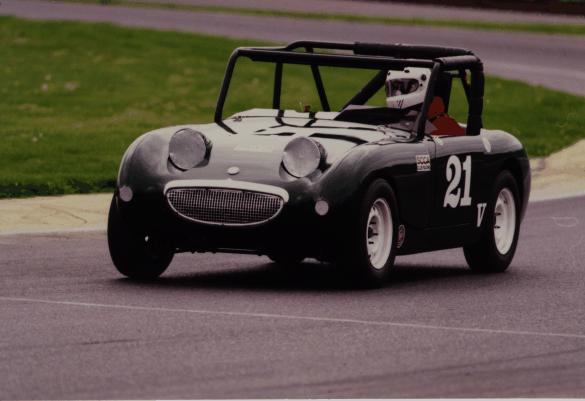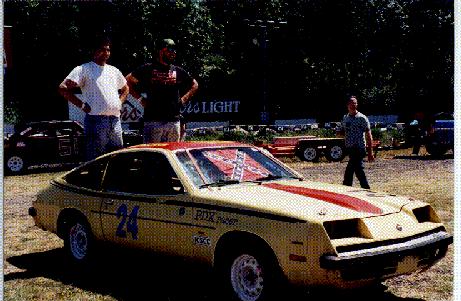

Hi, I'm Jeff Zurschmeide, and I'm writing this column for Richard Welty's web site. It's going to be an ongoing kind of thing, as long as Richard lets me.
I grew up around racing, as my parents and most of their friends were racers in the San Diego Region of SCCA in the 70s, and did Autocross, Rally, and Solo I before that.
My own racing experience started in 1988, with the formation of Fizzball Racing in Santa Cruz, CA, and our campaign at the local dirt track courses of our 1971 Ford Gran Torino Sport, suitably decked out for the lowest rung of the dirt track racing scene - the "Charger" series of enduros.
In 1991, I went through SCCA driver's school in San Francisco Region, and have been driving my 1959 Austin-Healey Sprite in SCCA events since then. From 1991 to 1994, I drove the car in H Production and from 1995 on, in Vintage. I'm also an SCCA Steward and scrutineer, working mainly out of Oregon Region. That's me in my bugeye...

In 1993, I again caught the circle-track bug. But this time it's on the 1/2 mile paved oval at Portland Speedway. But it's fundamentally the same game we used to play at Watsonville and San Jose speedways: a class of "Beater Stocks" running in enduro races. For those that have never been to the local speedway, most stock car racing is done in heat races of 20 laps or fewer. The enduros we run tend to be 300 or 500 laps, depending on the size of the track.
From 1994 to 1996, I built and campaigned (with a lot of help from my friends) a 1979 Monza V8 in the local enduro class (shown below, that's me in the black t-shirt. The other guy in the car is Miq Millman). My current project is assembling a 1976 Camaro for the same class. The Camaro has better performance potential, and they changed the rules to make the Monza illegal, so it's not like I really have a choice.

One of the nice things about spreading around your racing is that you get to experience the new and refreshing way different sanctioning bodies run their races and write their rules. Unlike the highly specific and lengthy SCCA race car specifications, the rules for the Enduro series are about 3 pages, one page of which is devoted to driving and behavior rules. The driving and behavior rules can be distilled to "don't be a jerk" - and being that simple, it's really surprising how many folks run afoul of the rulebook.
But the point of this column, and the next few, is to describe the process by which the PDXracer team takes a Camaro from essentially junkyard condition and prepares it for the next Enduro, which is scheduled for Memorial Day, May 26, 1997. Let's see if we get there.
Right now, as I type, the car is sitting on my trailer outside my shop, waiting for me to clean a space to get started working on it. It's January 30, and frankly, I'm concerned about having enough time to pull it all together. (I have a job and these people who claim to be my family, you see....)
The rules of car preparation are simple enough - I'll outline them for you:
That about covers the rules of car prep. All the major points, anyway. Driving rules are equally simple: When the yellow flag and light come on, the whole course is yellow. Gather it up and get in line, when you can. Red flag and light means stop now, or as soon as you can, more or less. Green means stand on it. Don't hit anyone hard in the driver's door if you can help it.
One time, the "pace car" was a guy on a Quad-runner. Yup, I'm not kidding. He wore a helmet when he banzaied that little beach-runner onto the course with 60+ beater stocks going full tilt, so I guess it was OK. Yeah, right. Lately, they've had kind of a modified cop car arrangement for the pace car.
There's a guy who's the judge, jury, and executioner of all driving offenses. All violations are up to him to see, note, and punish. He can toss you out of the race if he feels like it. There is no appeal.
Well, OK, so the track safety isn't up to SCCA standards. So they tend to just ignore passing under the yellow and gaining positions on a red flag. In the end, if you're there to prove that you're the smoothest and most capable racer in the world, you're in the wrong venue. This is just for fun, although the winner does go home with $1500, but without his car, which is forfeit to the organizers. (Second place gets $500 and his car, which is to my mind a much better deal.)
But the main point is, it's a big fun event, starting over 60 cars on a 1/2 mile track. Your license to race is the $50 you paid to enter and the $20 you paid for your pit/driver's pass. Your work on your car is the major safety investment made on your behalf. There's nothing in the world like it, especially if you are used to driving in Vintage in a little bug-eyed sprite.
Well, first thing I'm going to do is clean up a space in my shop and strip down that Camaro and find someone to put a cage in it. I'll try to take pictures as I go and publish them here. Future columns will detail the progress right on up to the race. I've got a Chevy 350 and a Turbo-Hydramatic transmission ready to go in. Brakes and all that are in good shape. I'm going to go with a wire-mesh windshield this year, and we're painting this big bad boy gloss black with Hot Pink highlights. (A nod to the original #21 FizzCar.)
More as it happens...
This article copyright 1997 by Jeff Zurschmeide. All Rights Reserved.